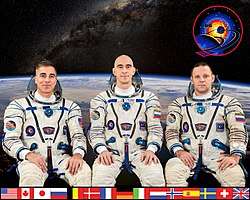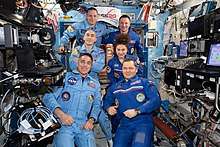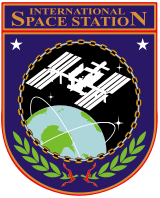Expedition 63
Expedition 63 is the 63rd and current long duration mission to the International Space Station, which began on 17 April 2020 with the undocking of the Soyuz MS-15 spacecraft and will continue until the undocking of the Soyuz MS-16 spacecraft in October 2020, an unusual double-length expedition increment.[2] The Expedition initially consisted of American commander Chris Cassidy, as well as Russian flight engineers Anatoli Ivanishin and Ivan Vagner.[3] On 31 May 2020, the Expedition welcomed the crew of Crew Dragon Demo-2, the first crewed flight of SpaceX's Crew Dragon spacecraft, named Endeavour after the eponymous Space Shuttle vehicle. The mission's two crew members Doug Hurley and Bob Behnken are scheduled to remain on board the ISS for 45 to 75 days to help bolster research on the station and participate in several spacewalks outside of the station.[4][5] The crew should also be joined by the three crewmembers of Soyuz MS-17 towards the end of the Expedition. Depending on the success of Dragon Crew Demo-2, the crew may also welcome the crew of Crew-1, the first operational flight of Dragon Crew and the Commercial Crew Program, in late 2020.
| Mission duration | 70 days, 19 hours and 13 minutes (elapsed - in progress) |
|---|---|
| Expedition | |
| Space Station | International Space Station |
| Began | 17 April 2020[1] |
| Arrived aboard | Soyuz MS-16 Crew Dragon Demo-2 SpaceX Crew-1 Soyuz MS-17 |
| Crew | |
| Crew size | 3-10 (cumulative total: 12) |
| Members |
|
| EVAs | 1[1] |
| EVA duration | 6h 07m[1] |
  (l-r) Chris Cassidy, Anatoly Ivanishin and Ivan Vagner | |
Crew
The following table assumes that Crew-1 launches on time as planned,[6][7][8] and reaches the ISS before Soyuz MS-17.
| Position | April–May 2020 | June–August 2020 | August 2020 | August/September–October 2020 | October 2020 |
|---|---|---|---|---|---|
| Commander | Third spaceflight | ||||
| Flight Engineer 1 | Third spaceflight | ||||
| Flight Engineer 2 | First spaceflight | ||||
| Flight Engineer 3 | Third spaceflight |
Second spaceflight | |||
| Flight Engineer 4 | Third spaceflight |
First spaceflight | |||
| Flight Engineer 5 | Third spaceflight | ||||
| Flight Engineer 6 | Second spaceflight | ||||
| Flight Engineer 7 | Second spaceflight | ||||
| Flight Engineer 8 | First spaceflight | ||||
| Flight Engineer 9 | Second spaceflight | ||||
Crewed spaceflights to the ISS

| Mission | Astronauts | Docking (UTC) | Undocking (UTC) | Duration |
|---|---|---|---|---|
| Crew Dragon Demo-2 | 31 May 2020 14:27 (hard docking) [13] |
13 August 2020 (no later than) | 45–75 days (planned) | |
| SpaceX spacecraft C206, later named Endeavour in honor of the Space Shuttle orbiter that replaced the Space Shuttle Challenger, which was destroyed in 1986,[14] launched to the station on 30 May and docked to the station approximately 19 hours later. The flight marks the first crewed test flight of SpaceX's Crew Dragon spacecraft and the first crewed spaceflight to launch from the United States since STS-135 in July 2011. The flight was originally planned as a short two-week test flight, but was extended due to delays. Crew members Doug Hurley and Bob Behnken will remain aboard the station for approximately three months. Final mission duration will depend on the readiness of Crew-1, which could launch approximately a month after the landing of Demo-2 and join either Expedition 63 or Expedition 64, and is currently planned for launch around September 2020.[8][6] | ||||
Extravehicular activity

Since delays to the NASA Commercial Crew Program could have left Cassidy as the only crew member on the USOS for an extended period of time, Anatoli Ivanishin has carried out training on American Extravehicular Mobility Unit (EMU) spacesuits. In the unlikely event that an unscheduled EVA had to take place before any more USOS crew members arrived on the station, if Ivanishin had taken part in an EVA in the EMU, he would have been the first Russian cosmonaut to use an EMU since Yuri Malenchenko (who performed the EVA with NASA Astronaut Peggy Whitson) during Expedition 16 in 2007.[15] For the same reason, Vagner has had to train on the USOS Robotic Arm (Canadarm2) in order to robotically support any spacewalk carried out by Cassidy and Ivanishin. With the flight of Crew Dragon Demo-2 being extended to approximately 75 days, NASA astronauts Doug Hurley and Bob Behnken were trained to carry out any EVAs alongside Cassidy if the need arose. During any excursions, Cassidy and Behnken would perform the EVAs with Hurley supporting the spacewalk robotically from inside the station.[16]
Later this year, several spacewalks are planned to carry out work on the scientific and power systems on the ISS. This includes work activating the Bartolomeo scientific package located on the outside of the Columbus laboratory module, which was delivered on CRS-20 earlier in the year.[17] NASA revealed on 19 May 2020 that with Demo-2 plans solidified, they were now planning as many as five EVAs by Cassidy and Behnken to install Bartolomeo and replace the remaining nickel-hydrogen batteries on the S6 Truss with new lithium-ion batteries.[18]
References
- "ISS Expedition 63". Retrieved 26 June 2020.
- "Increment 63" (in Japanese). JAXA. 10 April 2020. Retrieved 10 April 2020.
- Potter, Sean (30 October 2019). "NASA Assigns Chris Cassidy to Next Space Station Crew, Holds Briefing". NASA.

- Groh, Jamie (19 March 2020). "SpaceX, NASA ready for first crewed launch from US soil in almost a decade".
- Clark, Stephen (17 April 2020). "NASA, SpaceX set May 27 as target date for first crew launch". Spaceflight Now. Pole Star Publications. Retrieved 17 April 2020.
- "New NASA spaceflight chief makes no guarantees about 2024 Moon landing goal". Spaceflight Now. 18 June 2020. Retrieved 19 June 2020.
- "Launch America - a partnership between NASA and private space companies – will help open the space above Earth to people besides government astronauts". NASA.

- Bartels, Meghan (26 May 2020). "SpaceX's 1st astronaut launch will be a "unique moment" for America, NASA chief says". Space.com. Retrieved 26 May 2020.
- @anik1982space (9 May 2020). "Вот и новые составы российских экипажей «Союза МС-17» стали известны из пресс-релиза аэропорта Жуковский.
Основной: Сергей Рыжиков, Сергей Кудь-Сверчков.
Дублирующий: Олег Новицкий, Пётр Дубров.
К сожалению, Николая Тихонова и Андрея Бабкина нет..." (Tweet) (in Russian) – via Twitter. - "Flight crew assignments". forum.nasaspaceflight.com.
- https://tass.ru/kosmos/8456907
- Garcia, Mark (31 May 2020). "Station Welcomes First SpaceX Crew Dragon with Astronauts". NASA. Retrieved 1 June 2020.

- Potter, Sean (29 May 2020). "Updates to Coverage of Landmark NASA SpaceX Commercial Crew Test Flight". nasa.gov. NASA. Retrieved 31 May 2020.

- "Live coverage: NASA astronauts launch from U.S. soil for first time in nine years". Spaceflight Now. 30 May 2020.
- "Russian Cosmonauts May Conduct Spacewalk In US-Made Spacesuits In 2020 - Training Center". UrduPoint. Retrieved 13 November 2019.
- Clark, Stephen. "NASA, SpaceX set May 27 as target date for first crew launch – Spaceflight Now".
- "Spacesuit Work and Heart Research Fill Crew Day – Space Station". blogs.nasa.gov.

- Corbett, Tobias (19 May 2020). "NASA outlines the near and far future of the Space Station". NASASpaceflight.com. Retrieved 21 May 2020.
External links

